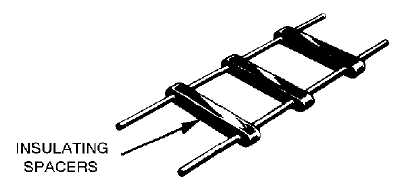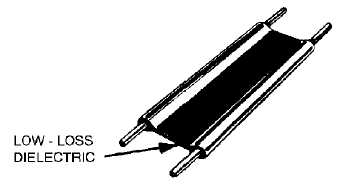3-3
The five types of transmission mediums that we will discuss in this chapter include
PARALLEL-LINE, TWISTED PAIR, SHIELDED PAIR, COAXIAL LINE, and WAVEGUIDES. The
use of a particular line depends, among other things, on the applied frequency, the power-handling
capabilities, and the type of installation.
NOTE: In the following paragraphs, we will mention LOSSES several times. We will discuss these
losses more thoroughly under "LOSSES IN TRANSMISSION LINES."
Two-Wire Open Line
One type of parallel line is the TWO-WIRE OPEN LINE illustrated in figure 3-2. This line consists
of two wires that are generally spaced from 2 to 6 inches apart by insulating spacers. This type of line is
most often used for power lines, rural telephone lines, and telegraph lines. It is sometimes used as a
transmission line between a transmitter and an antenna or between an antenna and a receiver. An
advantage of this type of line is its simple construction. The principal disadvantages of this type of line
are the high radiation losses and electrical noise pickup because of the lack of shielding. Radiation losses
are produced by the changing fields created by the changing current in each conductor.
Figure 3-2.—Parallel two-wire line.
Another type of parallel line is the TWO-WIRE RIBBON (TWIN LEAD) illustrated in figure 3-3.
This type of transmission line is commonly used to connect a television receiving antenna to a home
television set. This line is essentially the same as the two-wire open line except that uniform spacing is
assured by embedding the two wires in a low-loss dielectric, usually polyethylene. Since the wires are
embedded in the thin ribbon of polyethylene, the dielectric space is partly air and partly polyethylene.
Figure 3-3.—Two-wire ribbon type line.



